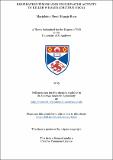Files in this item
Respiration timing and underwater activity in killer whales (Orcinus orca)
Item metadata
| dc.contributor.advisor | Miller, Patrick | |
| dc.contributor.author | Roos, Marjoleine M.H. | |
| dc.coverage.spatial | xii, 167 | en_US |
| dc.date.accessioned | 2015-07-10T10:53:16Z | |
| dc.date.available | 2015-07-10T10:53:16Z | |
| dc.date.issued | 2015-06-24 | |
| dc.identifier.uri | https://hdl.handle.net/10023/6958 | |
| dc.description.abstract | Accurate estimates of energetic requirements of top predators in-situ are essential to improve sustainable marine ecosystems’ management. Yet, obtaining direct energetic measurements of free-ranging cetaceans is unfeasible. Breathing rate has been used as indicator of cetacean metabolic rates, though rate alone does not account for breath-by-breath variation in gas exchange. This study’s aim was to investigate 1) the strength of correlations between respiration rates and underwater activity levels; and 2) the potential influence of including respiratory timing (besides rate) and oxygen uptake dynamics on in-situ cetacean energetic studies. Kinematic data from 12 adult wild Norwegian herring-feeding killer whales (Orcinus orca) were recorded with high-resolution tags (DTAGs) to reveal individual breathing events. Three-axis accelerometer and flow noise data were used to derive stroking rate and speed as underwater activity level metrics. An oxygen exchange model, including an oxygen uptake curve as key feature, and oxygen consumption from swimming speed or stroke number, was established to estimate oxygen extraction dynamically per individual breath, based upon modelled oxygen store at the time of each breath. Correlations between predicted oxygen uptake and activity level over 15 min periods were relatively weak when using constant uptake per breath (for both speed and stroking r² < 0.1). Including fluctuating oxygen uptake per breath significantly improved the correlation between modelled oxygen uptake and activity (for both speed and stroking r² > 0.9). Model outcomes found that cost of transport kept decreasing when assuming fixed oxygen uptake, whereas applying fluctuating uptake revealed a clear minimum cost of transport speed of 2.0-2.5 m·s⁻¹. With on-going development and effort concerning bio-logging, together with gain of accurate information on energetic costs relating to kinematics, the proposed model could become a useful tool to improve our knowledge of free-ranging cetaceans’ energetic requirements in relation to more advanced sustainable marine ecosystem management. | en_US |
| dc.language.iso | en | en_US |
| dc.publisher | University of St Andrews | |
| dc.rights | Creative Commons Attribution-NonCommercial-NoDerivatives 4.0 International | |
| dc.rights.uri | http://creativecommons.org/licenses/by-nc-nd/4.0/ | |
| dc.subject | Respiration timing | en_US |
| dc.subject | Oxygen uptake curve | en_US |
| dc.subject | Energetics | en_US |
| dc.subject | Cost of transport | en_US |
| dc.subject | DTAG | en_US |
| dc.subject | Killer whale | en_US |
| dc.subject | Cetaceans | en_US |
| dc.subject.lcc | QL737.C432R7 | |
| dc.subject.lcsh | Killer whale | en_US |
| dc.subject.lcsh | Respiration--Measurement | en_US |
| dc.subject.lcsh | Biothermodynamics | en_US |
| dc.title | Respiration timing and underwater activity in killer whales (Orcinus orca) | en_US |
| dc.type | Thesis | en_US |
| dc.type.qualificationlevel | Doctoral | en_US |
| dc.type.qualificationname | MPhil Master of Philosophy | en_US |
| dc.publisher.institution | The University of St Andrews | en_US |
| dc.publisher.department | School of Biology, Sea Mammal Research Unit | en_US |
This item appears in the following Collection(s)
Except where otherwise noted within the work, this item's licence for re-use is described as Creative Commons Attribution-NonCommercial-NoDerivatives 4.0 International
Items in the St Andrews Research Repository are protected by copyright, with all rights reserved, unless otherwise indicated.


